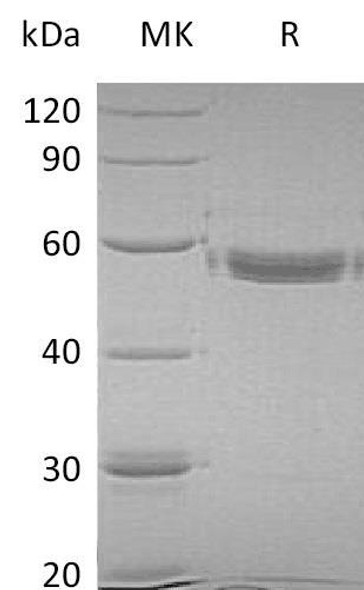Enzymes Recombinant Proteins
Human MMP1 (24-207) Recombinant Protein (RPPB1953)
- SKU:
- RPPB1953
- Product Type:
- Recombinant Protein
- Species:
- Human
- Uniprot:
- P01033
- Research Area:
- Enzymes
Description
| Product Name: | Human MMP1 (24-207) Recombinant Protein |
| Product Code: | RPPB1953 |
| Size: | 10µg |
| Species: | Human |
| Target: | MMP1 (24-207) |
| Synonyms: | nterstitial collagenase, Fibroblast collagenase, Matrix metalloproteinase-1, MMP-1, MMP1, CLG, CLGN. |
| Source: | HEK293 Cells |
| Physical Appearance: | Filtered White lyophilized (freeze-dried) powder. |
| Formulation: | MMP1 (24-207) filtered (0.4 �m) and lyophilized from 0.5mg/ml in PBS, pH7.5 and 5% (w/v) Threalose. |
| Solubility: | It is recommended to add deionized water to prepare a working stock solution of approximately 0.5mg/ml and let the lyophilized pellet dissolve completely. |
| Stability: | Store lyophilized protein at -20°C. Aliquot the product after reconstitution to avoid repeated freezing/thawing cycles. Reconstituted protein can be stored at 4°C for a limited period of time; it does not show any change after two weeks at 4°C. |
| Purity: | Greater than 95.0% as determined by SDS-PAGE. |
| Amino Acid Sequence: | CTCVPPHPQT AFCNSDLVIR AKFVGTPEVN QTTLYQRYEI KMTKMYKGFQ ALGDAADIRF VYTPAMESVC GYFHRSHNRS EEFLIAGKLQ DGLLHITTCS FVAPWNSLSL AQRRGFTKTY TVGCEECTVF PCLSIPCKLQ SGTHCLWTDQ LLQGSEKGFQ SRHLACLPRE PGLCTWQSLR SQIAHHHHHH |
MMP-1 (interstitial collagenase) can break down a wide range of substrates including types I, II, III, VII, VIII, and X collagens as well as L-Selectin, pro-TNF, IGFBP-3, IGFBP-5, casein, gelatin, myelin basic protein, pro-MMP2 and pro-MMP9. A significant function of MMP-1 is the degradation of fibrillar collagens in extracellular matrix remodeling. MMP-1 is expressed in fibroblasts, keratinocytes, endothelial cells, monocytes and macrophages. MMP1 can be divided into a number of distinct domains: a prodomain which is cleaved on activation, a catalytic domain containing the zinc binding site and a short hinge region with a carboxyl terminal domain. MMP1 is part of a cluster of MMP genes which localize to chromosome 11q22.3.
MMP1 (24-207) Human Recombinant is a single, glycosylated polypeptide chain containing 190 amino acids and having a molecular mass of 21.2kDa. MMP1 (24-207) is fused to a 6 a.a C-terminal His tag. �
| UniProt Protein Function: | TIMP1: Complexes with metalloproteinases (such as collagenases) and irreversibly inactivates them by binding to their catalytic zinc cofactor. Also mediates erythropoiesis in vitro; but, unlike IL-3, it is species-specific, stimulating the growth and differentiation of only human and murine erythroid progenitors. Known to act on MMP-1, MMP-2, MMP-3, MMP-7, MMP-8, MMP-9, MMP-10, MMP-11, MMP-12, MMP-13 and MMP-16. Does not act on MMP-14. Belongs to the protease inhibitor I35 (TIMP) family. |
| UniProt Protein Details: | Protein type:Motility/polarity/chemotaxis; Secreted, signal peptide; Secreted Chromosomal Location of Human Ortholog: Xp11.3-p11.23 Cellular Component: extracellular space; proteinaceous extracellular matrix; extracellular region; basement membrane Molecular Function:metalloendopeptidase inhibitor activity; protein binding; growth factor activity; protease binding; metal ion binding; cytokine activity Biological Process: response to peptide hormone stimulus; platelet activation; extracellular matrix organization and biogenesis; negative regulation of metalloenzyme activity; response to hormone stimulus; negative regulation of membrane protein ectodomain proteolysis; extracellular matrix disassembly; platelet degranulation; response to cytokine stimulus; positive regulation of cell proliferation; blood coagulation; aging; negative regulation of apoptosis |
| NCBI Summary: | This gene belongs to the TIMP gene family. The proteins encoded by this gene family are natural inhibitors of the matrix metalloproteinases (MMPs), a group of peptidases involved in degradation of the extracellular matrix. In addition to its inhibitory role against most of the known MMPs, the encoded protein is able to promote cell proliferation in a wide range of cell types, and may also have an anti-apoptotic function. Transcription of this gene is highly inducible in response to many cytokines and hormones. In addition, the expression from some but not all inactive X chromosomes suggests that this gene inactivation is polymorphic in human females. This gene is located within intron 6 of the synapsin I gene and is transcribed in the opposite direction. [provided by RefSeq, Jul 2008] |
| UniProt Code: | P01033 |
| NCBI GenInfo Identifier: | 135850 |
| NCBI Gene ID: | 7076 |
| NCBI Accession: | P01033.1 |
| UniProt Secondary Accession: | P01033,Q14252, Q9UCU1, |
| UniProt Related Accession: | P01033 |
| Molecular Weight: | 23,171 Da |
| NCBI Full Name: | Metalloproteinase inhibitor 1 |
| NCBI Synonym Full Names: | TIMP metallopeptidase inhibitor 1 |
| NCBI Official Symbol: | TIMP1�� |
| NCBI Official Synonym Symbols: | EPA; EPO; HCI; CLGI; TIMP�� |
| NCBI Protein Information: | metalloproteinase inhibitor 1; TIMP-1; collagenase inhibitor; erythroid potentiating activity; erythroid-potentiating activity; fibroblast collagenase inhibitor; tissue inhibitor of metalloproteinases 1 |
| UniProt Protein Name: | Metalloproteinase inhibitor 1 |
| UniProt Synonym Protein Names: | Erythroid-potentiating activity; EPA; Fibroblast collagenase inhibitor; Collagenase inhibitor; Tissue inhibitor of metalloproteinases 1; TIMP-1 |
| Protein Family: | Metalloproteinase inhibitor |
| UniProt Gene Name: | TIMP1�� |
| UniProt Entry Name: | TIMP1_HUMAN |






